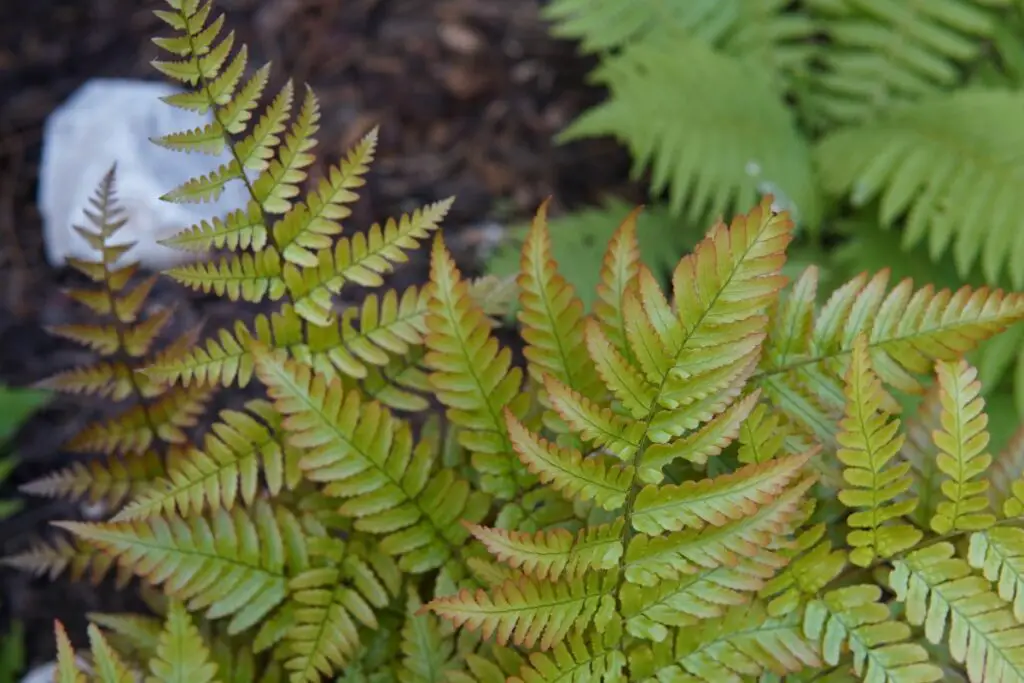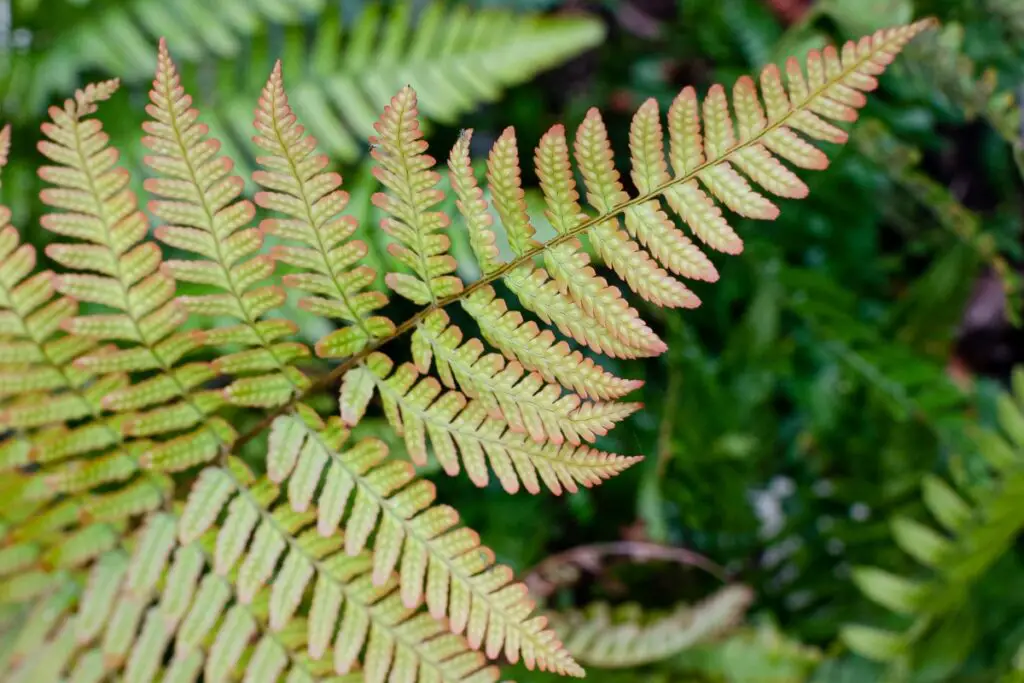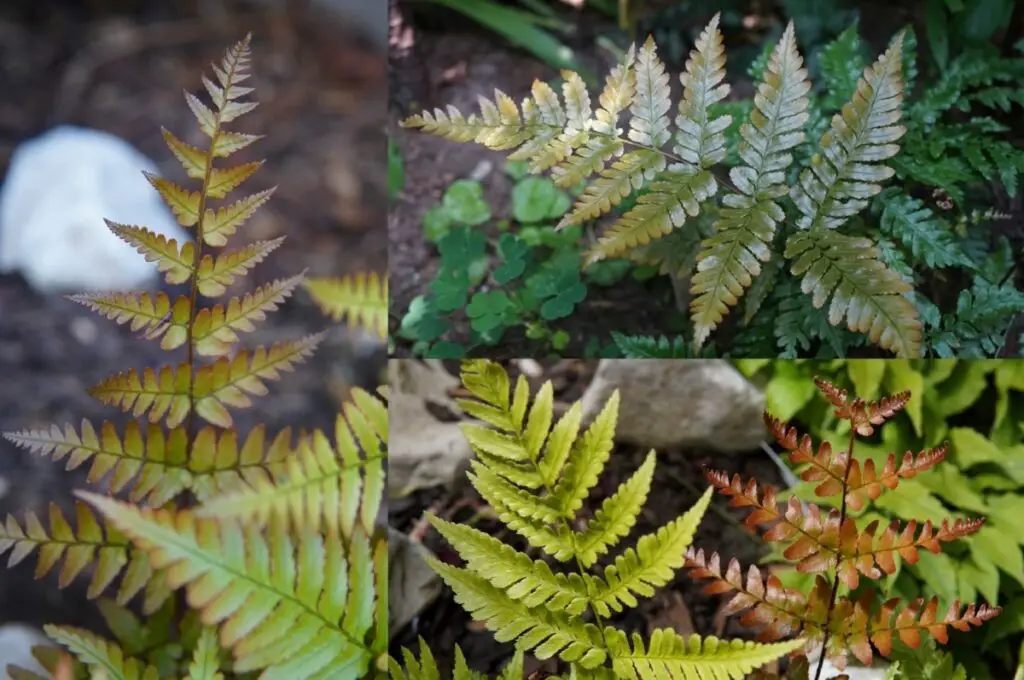The Autumn fern is a beautiful, reliable, evergreen and robust fern – both a star and a workhorse of the garden. It is most admired for the beautiful pink/red coloration of the new fiddleheads that emerge in the spring, which then turn bronze and green as they mature, often leaving a lovely coppery fringe to the tips of the frond during much of the growing season.
As well as winning awards for its aesthetic merit, the Autumn fern is a flexible and resilient variety which can tolerate a wide range of soil types, watering schedules, and sun exposure. A true all-rounder, the Autumn fern looks good in all seasons.

Common names
- Autumn fern
- Copper shield fern
- Japanese shield fern
- Japanese red shield fern
Botanical names
- Dryopteris erythrosora
- Aspidium erythrosorum
Growth habit
Autumn ferns are crown-forming and do not spread through the soil. Fiddleheads emerge from a clump of rhizomes at the base of the crown, forming a classic “shuttlecock” shaped bush of foliage.
The new growth in spring is red/pink colored and fades to a coppery tinge, and it is this feature that gives the fern its common names (as it is reminiscent of the shades of Autumn). The fronds are triangular and “bipinnate” with the leaflets being divided twice. The texture is glossy, and once the fertile fronds mature, characteristic red sori (the circular packets of spores) form on the underside.

The crown typically grows to around 2 ft under normal conditions, but can reach up to 3 ft (1 m) in height and spread under optimal conditions. It can take 5 to 10 years to reach full maturity.
When first planted out from a pot, the base of the crown should be sunk to the level of the soil surface, before mulching. If it is planted too high, watering can erode the soil around the rhizomes and roots and stress the plant.
Hardiness
The Autumn fern is native to east Asia: Japan, China, Korea and the Philippines. It is tolerant of cold temperatures down to around -10 °F (-20 °C), and so can be successfully grown in USDA hardiness zone 6 or higher. It would struggle in more northerly states.
Autumn ferns are usually evergreen, but can be semi-evergreen in colder climates and lose fronds in harder winters. In my fernery in the UK Midlands (equivalent to USDA zone 8), Autumn ferns remain bushy and impressive all through the winter, and only lose some of the vibrancy of their greenness – becoming more lime green or yellow.
Sun exposure
Autumn ferns can tolerate a wide range of different light levels – from deep shade to full sun. In open spots where the fern is exposed to sun throughout the day, it should be well watered (around the rhizome and roots, in the evening or morning) to deal with the combination of intense sun and dryness.
While this adaptability to different conditions is admirable, in my experience Autumn ferns seem to lose their copper color more quickly when grown in full sun, so if you want to preserve this beauty it is probably best to plant in full or partial shade.
Watering
In terms of the demands for ongoing support and maintenance, Autumn ferns are very forgiving!
Autumn ferns prefer moist, well-drained soil conditions, but as with sun exposure, they can actually tolerate a range of watering regimes. They can therefore survive short periods of drought, and can be left alone under average levels of rainfall. If you do experience a long, dry spell then it is worth watering directly. While they are tough and dependable, Autumn ferns are not a desert species, and so will need rescue at some point.
Similarly, Autumn ferns can manage well even in wet soil that is slow to drain. Long bouts of rainfall or surface flooding are therefore also no problem, and only the most waterlogged conditions will cause lasting harm.
Soil conditions
Autumn ferns will grow in almost any type of soil, from sandy or chalky soil through to clay. They will also tolerate a range of soil pH – acid, neutral or alkaline. Despite this flexibility, the best conditions for growth seem to be acid or neutral pH and well-drained soil with plenty of organic content.
Wherever you plant them, it is a good plan to add a generous organic mulch around the crown, both to trap moisture and to provide nutrients to be released over time.
Propagation
Autumn ferns can be propagated by division or by spore fertilization.
To divide a mature plant it is best to dig up the whole plant (and full root ball) in the spring, and cut the tangle of rhizomes and roots into sections, ensuring that there is evidence of new growth (emerging fiddleheads) in each section that you separate. Replant into pots or new locations quickly, submerging the rhizomes to just below the surface of the soil or potting mix. Water well over several days to help the new specimens become established.
Propagation from spores is also possible, if patient, and follows the same principles as for other fern species.
Varieties and cultivars
The classic Autumn fern, Dryopteris erythrosora, is widely available in garden centers and nurseries, but there is some debate about whether several species in cultivation are sold under this name. There is little to distinguish them, however, so you will get good results from any of these varieties.
A couple of notable cultivars are gaining popularity. Drypoteris erythrosora ‘Brilliance’ has fiddleheads that are an especially vibrant red color, emphasizing the best feature of the plant.

Another cultivar, Drypoteris erythrosora ‘Prolifica’, has a more narrow, finely divided structure to the fronds and can grow to a greater height than the parent plant. This gives some variety in appearance that can be attractive, having less the overall density to the shuttlecock crown of the fern.

Autumn ferns are the best first choice for anyone interested in adding ferns to their garden. They are easy to grow, tolerant of a wide range of growing conditions, and have some of the most attractive foliage of any fern species. They are a true gem, and provide beauty and satisfaction all year round.
